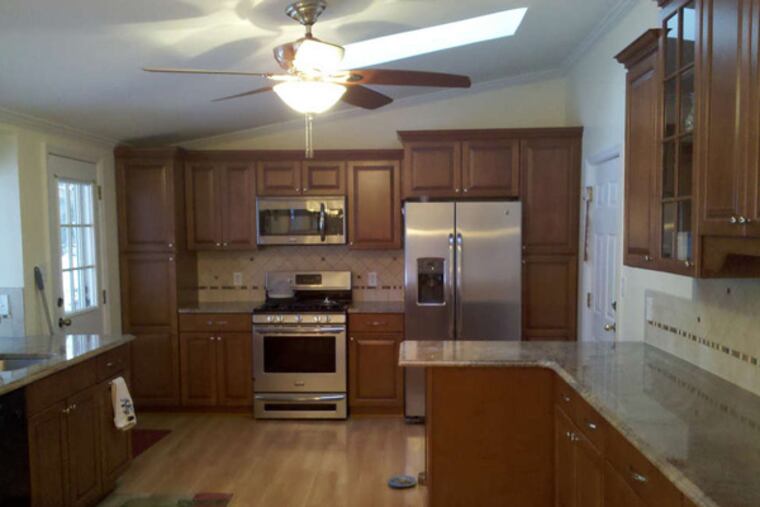Pick your home fix-ups wisely
Face it: You must do something with the kitchen. Some cabinets have lost hinges, at least one appliance has acquired its own thought process, the vinyl floor is curling, the Formica countertop is chipping and dipping, and the lighting . . . well, lightning bugs have more wattage.

Face it: You must do something with the kitchen.
Some cabinets have lost hinges, at least one appliance has acquired its own thought process, the vinyl floor is curling, the Formica countertop is chipping and dipping, and the lighting . . . well, lightning bugs have more wattage.
The family budget cannot allow a major overhaul.
So what to replace, and at what cost?
The questions end there if the homeowner doesn't care about the return on investment. Otherwise, owners ought to seek out the annual Cost vs. Value Report.
Some homeowners fail to understand what the figures in the report mean. Quakertown designer Kathy Appel said she had a client who only wanted to spend what the data showed as the payback on a kitchen remodel, convinced that a buyer would pay that amount.
It doesn't work that way.
The data comprising the annual report, published by Realtor magazine and the National Association of Realtors, are based on member-supplied estimates, not real jobs. Also, all 35 projects listed are "constructed" with generic products. These projects include remodeling and reconstruction.
You need to consider real-life variables, such as timing. The market might be fine when you're fixing up, and a mess when you're selling. So an expected 75 percent return might turn into 20 percent, said Paul Bondy, president of Exit Realty in Ambler. "Any improvements . . . you are not really going to make a huge profit at the other end."
Another consideration: your neighborhood. "Don't over-improve for the neighborhood you are in," said Cyndi Haaz, a designer and general contractor in Furlong. "If you want a return on your investment, a professional can help."
The important question is, how long will you stay in your home?
Do what you want if you're staying. But, if you're planning to sell in about five years, and want a return on your investment, then think, in terms of redesign, more vanilla-flavored than cherries jubilee. Be careful of nascent trends, such as wallpaper, Appel said; they take a while to take hold. If you are planning to move in a few years, paint now, don't paper.
For the Philadelphia area, the Cost vs. Value Report shows the median cost of "minor" kitchen-remodeling project to be about $21,000. (A major one is three times that.) The homeowner should expect about a 67 percent return. (This is the first year in six that the overall cost-vs.-value average, at 60.6 percent, has improved.) See the 2013 report at http://goo.gl/QbQYjv.
So what to improve, presuming you plan to leave in a few years?
No one interviewed for this article suggested replacing kitchen cabinets, but Appel, whose shop is called Hearth and Hedgerow, and Drew Miller, owner of Drew Miller Custom Builder in Collegeville, said painting cabinets, if necessary, is a good idea.
Miller sprays the doors. "They come out great," he said.
Most of those who were asked for their best general advice said to replace kitchen backsplashes and countertops. "I will add granite countertops, backsplash, appliances and maybe a new floor," said Bondy, who rehabs old houses.
A backsplash and countertop don't cost as much as cabinets, but they add new life, said John Matusik Jr., co-owner of B & M Custom Carpentry in West Deptford.
Older homes have Formica countertops and old-style wall tiles, which are immediately noticeable to potential home buyers. Most of the cabinets look the same. "But the countertops and backsplash . . . if they are out-of-date colors, [make] the whole kitchen look old. Changing [them] transforms the kitchen," Matusik said.
Then there is the lighting; Miller advised adding reset lights over the counter, a range hood if none was there, and a ceiling fan.
And don't forget new hardware.
One other thing: Is your kitchen designed in the efficient "work triangle" - a layout with the refrigerator, sink and stove as the points of an easy-to-navigate triangle? If not, Bondy said, you have decisions to make. Can you move the sink? Can you afford the overhaul?
Sometimes, informed owners will forgo dealing with a cost-vs.-value equation, if quality of life transcends a percentage sign.
Twenty years ago, Miller said, a client in Kensington said she wanted her kitchen a particular way; Miller said she would never recoup her investment. Her reply: I cook every day and I have no plans to leave.
Said Miller: "It's probably the most satisfying kitchen I ever did."